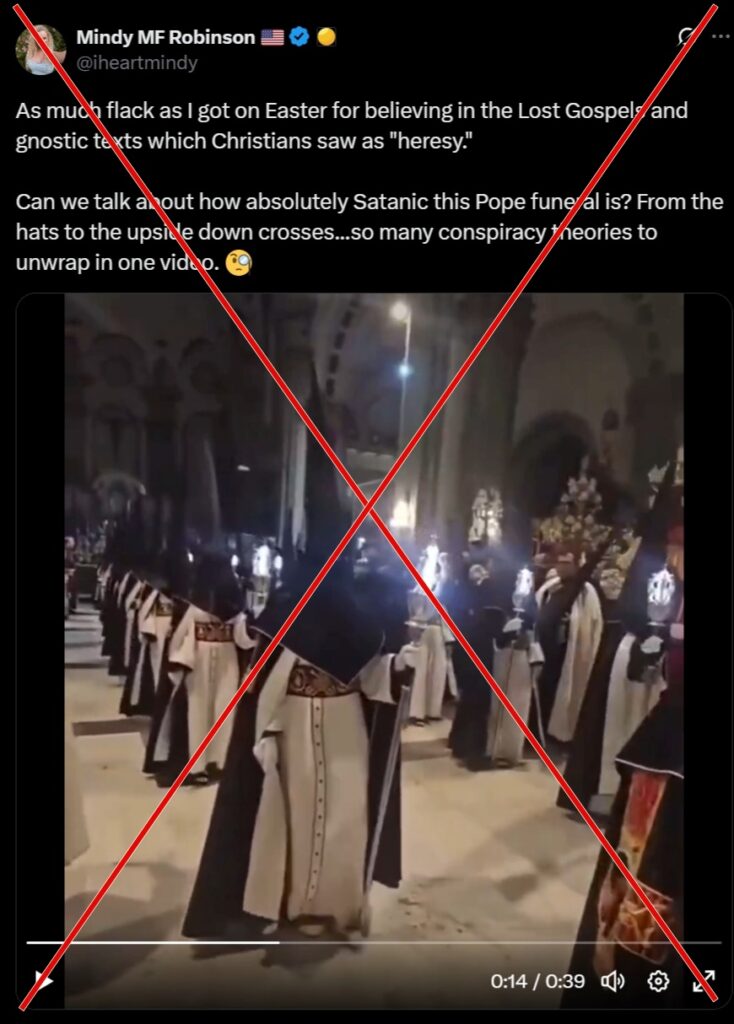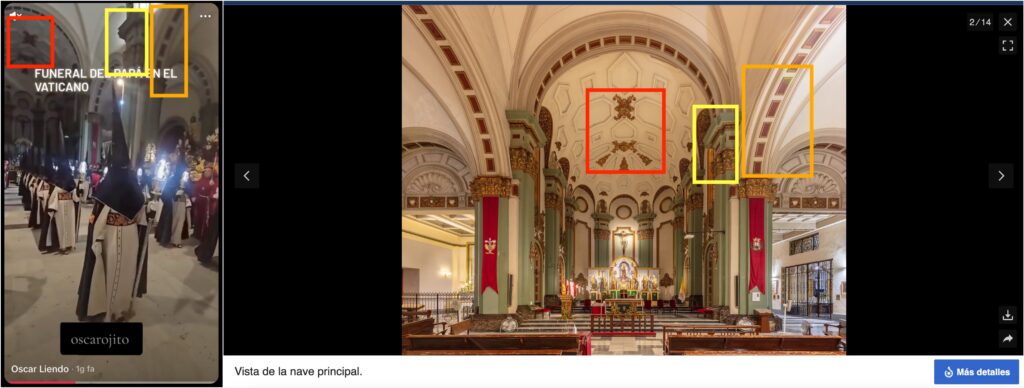CLAIM: This video shows a satanic ritual at the Vatican during the funeral of Pope Francis I.
CONCLUSION: A reverse video search shows that it actually depicts a Holy Week procession in Spain, where participants traditionally wear pointed hats known as “capirotes.” Furthermore, the inverted cross is a Catholic religious symbol, not a satanic one.
In April 2025, a video showing people wearing white and black robes and pointed hats marching to the beat of drums inside a church was shared hundreds of times, falsely claiming it depicted a satanic ritual at the Vatican during the funeral of Pope Francis I, who passed away on April 21, 2025, one day after Easter. These posts circulated on Facebook and X (formerly Twitter) on April 23, from an account known for spreading disinformation. In his edited video, the user pointed to a red inverted cross with a rooster in the middle as “proof” of a “satanic symbol.”
The same video was also shared in other languages, including English on YouTube, claiming it was “the satanic funeral of the Pope,” and in Spanish on TikTok.
One of the sources of the claim appears to originate from the account of pro-Trump TV personality Mindy Robinson, who posted the same video on her X account on April 22.

What we know:
A reverse video search led us to a Facebook video titled “Semana Santa URDA 2024” (Holy Week URDA 2024), with Urda being a town in Spain. Such processions during Holy Week in Spain are very common, and participants indeed wear the distinctive “capirote” pointed hat.
Based on these findings, we took a closer look at the location shown in the misleading video. By conducting a reverse image search using screenshots of details from inside the church, and using the highest-quality version of the video found on TikTok, we confirmed that the church in question is the Iglesia de Santa María de Gracia in the Spanish city of Cartagena. This identification was made by matching distinct architectural details, as shown in the image comparison below.

Next, we searched online using the Spanish keywords “Semana Santa Cartagena Murcia 2025” (Holy Week Cartagena Murcia 2025) and found a YouTube video posted by Cartagena TV. It was a livestream from April 16, 2025, showing the procession with participants wearing the same type of robes and “capirotes.” At the 2:07:42 mark of the video, the same inverted cross with the rooster in the middle is visible, as highlighted in the comparison images.

The group is known in Spanish as “Agrupación de San Pedro Apóstol” from the “Cofradía California” (California Brotherhood). The symbol of the group is the Cross of St. Peter, an inverted cross. It is in no way a “satanic symbol,” but rather the ancient Christian symbol representing the martyrdom of the Apostle Peter, who was crucified upside down. The group even explains the design of their robes in a detailed YouTube video.
Finally, the pointed hat or “capirote” worn by the participants is also not a “satanic” symbol. Religious brotherhoods in Spain traditionally wear this hat during Holy Week processions as a sign of penance, a tradition dating back to the Spanish Inquisition in the 15th century.
It was only in the early 20th century that the “capirote” was adopted by Ku Klux Klan, leading to its later associations with satanic imagery in popular imagination.
The funeral of Pope Francis will take place on Saturday, April 26, 2025, in the presence of many political leaders. His body has been placed in St. Peter’s Basilica in the Vatican for public viewing.
Conclusion:
The video shows a traditional Spanish Holy Week procession in Cartagena. It has nothing to do with any “satanic ritual” at the Vatican or the funeral of Pope Francis I.
